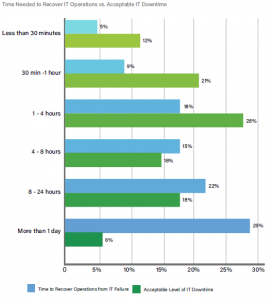
Inbound marketing or content marketing as it’s interchangeably called, has been enjoying its day in the sun for a few years now. Recent figures from Marketing Charts shows that 86% of B2C companies and 91% of B2B companies actively invest in inbound marketing.
This comes as no real surprise. Inbound marketing has proven its worth over the years as a cost-effective marketing strategy that delivers results that far surpass the investment that brands put in. According to HubSpot’s State of Inbound Report, businesses that focus primarily on inbound marketing save more than $14 on acquiring each new customer. Further, 80% of B2B decision makers prefer consuming brand related content over advertising while making a purchase decision. So far, so good.
Inbound marketing is not just cheaper – it’s preferred by customers too.
But sometimes, the best laid plans don’t pan out the way they were meant to. Nearly every business has been there. After spending weeks or months creating detailed inbound marketing strategies, developing fresh, original, quality content, and promoting this content aggressively nothing happens. The fabled silver bullet of inbound marketing fails to deliver. Organic traffic stays put. Social media referrals don’t show any change. Conversions stay immobile as ever. This is not supposed to be happening.
Or is it?
Know What You Really, Really Want
As we discussed earlier, the whole idea of Inbound Marketing is publishing content that acts as a magnet; drawing audiences in, showcasing the best features of your product or service. Easier said, than done. We’ve all seen graveyards of well-meaning content marketing efforts that reached nobody and brought little, to no results littered all over the internet.
But aren’t users supposed to come when you unleash your content on the internet?
Well, yes and no.
The purpose of content marketing is definitely to drive leads to your brand online and even in stores. However, no matter how awesome your content is, you’re never going to move the needle if the content you’ve put out there is irrelevant to your audience. Too many inbound marketers dive headlong into creating content – a lot of it, pretty high quality too – without ensuring that the content maps perfectly to the topics that their buyers care about.
In this era of content overkill, your potential customer has a million other things she can consume that she’s directly interested in without batting an eyelid. Lift the cloak of invisibility from your brand online by following the cardinal rule of inbound marketing – cater to the intent of your user. Understand what really matters to your users and then give them that. Intent based content is the cornerstone of a strong inbound marketing strategy.
Step one to identifying user intent, is uncovering the queries that users type in to discover your business or that of your competitors. Don’t limit yourself to researching keywords that matter. Look instead for keyword phrases that consumers are likely to use. With the rise and rise of voice search, using natural language queries as the jumping off point for your content marketing is more critical than ever.
Tools like SEMrush’s Topic Research offer in-depth insights into the keywords and keyword phrases that make most sense for your site. You can glean related terms from Google, questions people are asking on Quora and other forums, and headlines from most viewed and shared posts on relevant blogs.
Search Engine Land’s interesting analysis of the top keyword research tools is a good place to peek into before you make a choice for yourself.
Put Form Over Function
Now that you know what your buyers are looking for, don’t rush headlong into content creation. Your next step is to understand what type of content your target audience prefers to consume.
Data shows that video content leads all pother content forms in popularity. No surprises there. But it’s important to note that while 65% of young consumers prefer video content, just 43% of older consumers choose it. Similarly, gamified content is popular among younger audiences than older ones.
Similarly, the channels that you use to disseminate content also varies greatly based on your target audience. Snapchat and Instagram are the social media outlets of choice for younger users, while older audiences are still reliant primarily on Facebook. Free messaging apps like WhatsApp and WeChat are popular messaging apps in Asia, while Facebook Messenger and Snapchat are the apps of choice in the United States.
From generational differences to geographical ones, using a one-size-fits-all approach to content channels is a surefire way of wasting your inbound marketing dollars.
Time It Right, Place It Right
Success, they say, is a matter of being at the right place, at the right time. This could not be truer in the case of inbound marketing.
Just as you would not begin a dinner with dessert, you would not dangle a rate card for your SaaS solution before a first time visitor. Nor would you waste an opportunity to close the deal with a nurtured lead by not offering them an ROI calculator or a compelling case study.
No matter how brilliant your piece of content, it only truly matters when it is of actual use to the customer. At the right place. At the right time.
My favorite place to start understanding a customer’s journey is inside Google Analytics. Inspecting the kind of content different users consume on your own website at different stages in their journey and comparing that with conversion data is a good way to gauge where to include which type of content for your specific user.
Starting out a new business, don’t have much data on your website yet? Head to the reams of research that’s available online about content targeting users at different levels of the sales funnel and build from there.
Reel in that first time visitor with a slick video related to your general area of interest. Once they’re on your site, offer them engaging content like say, a style guide on a retailer’s website.
And oh, if you’re an online retailer with customers already in the checkout flow, makes sense to implement data-driven methods of customer service, by offering them tailor made promotions or discounts to close the sale quicker.
In Closing
Assuming that your content strategy is built on creativity, originality, quality research and frequency, addressing the factors we discussed here is key to making your inbound marketing productive.
Combine these steps with regular inbound marketing hygiene – maintaining your website’s user experience and optimizing it towards the most current ranking factors on Google – and you’ll be well on your way to becoming the envy of your competition!
Inbound marketing or content marketing as it’s interchangeably called, has been enjoying its day in the sun for a few years now. Recent figures from Marketing Charts shows that 86% of B2C companies and 91% of B2B companies actively invest in inbound marketing. This comes as no real surprise. Inbound marketing has proven its […]
The post Inbound Marketing Not Bringing You Results? Try This. appeared first on Search Engine People Blog.
(75)






